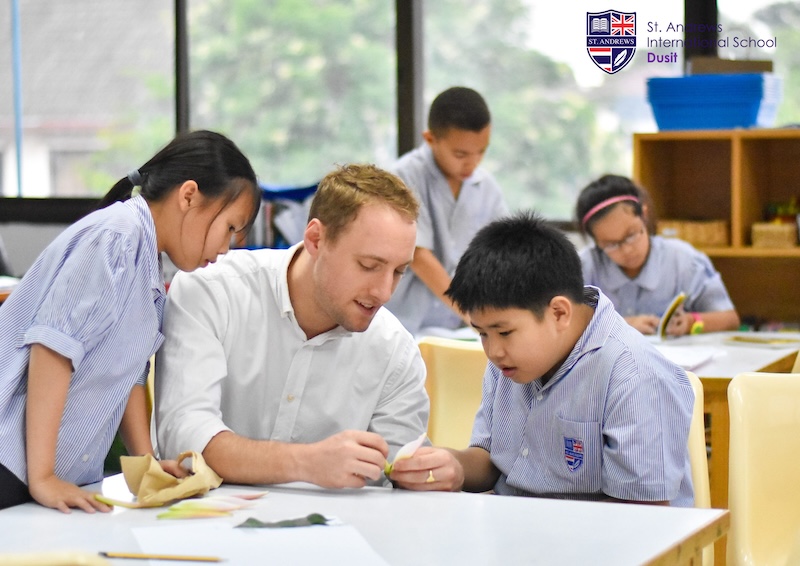We all know somebody who has experienced difficulties, whether it’s problems in concentration, language in a school environment, or behavioural problems and making friends in a social setting. For me, it is my 10 year-old nephew, whose speech delay was diagnosed as a disorder on the mild-side of the autism spectrum.
Most of us already know about it, but do we really know what to do and how to help? Luckily though, the awareness of learning disability issues is now wider in public than it ever was. Both private and government organisations are working closely to break down the stigma, discrimination, economic, social barriers, and more importantly the label that come with children with special needs.
Making his contribution to the cause is Harshi Sehmar, the director and founder of The Village International Education Centre near Ekamai. Harshi started the school some 15 years ago for children with special needs. But the story behind its inception is a personal one.
His-story
Harshi migrated to England from India with his family when he was just four. By the time he was 10, he was struggling to read and write and teachers figured the delay was due to English being a new language for him. By 15, he was deemed lazy and pulled out of class and put together with a group of kids who were termed as no-hopers. “We were put in a room and were basically given babysitting services. If you are told that you can’t do it, you fulfill that label. It’s a self fulfilling prophecy”, he recalls.
Harshi left school with virtually no qualifications and unable to read or write. At one point his father suggested that he try for a job at his factory, but Harshi refused. While working in a petrol garage, he took up evening classes. At these classes, he managed to get the skill set he needed to help him get through his qualifications. That is when he realised that he wanted to go into education.
After getting his bachelor’s in education, he worked as an education officer learning the mechanics of the education structure and understanding how to develop services focused towards children with special needs. He started out as a special needs teacher at Holland Park School in the UK and moved up very quickly in the staffing structure of the special needs department because of his specialised skills and empathy towards how these students felt.
Harshi moved to Thailand some 18 years ago to work and aided two large international schools develop their special needs department.
Harshi realised that there are many young people out there, not just in western societies but in every culture, who are struggling with learning to read and write. They are given a label of dyslexia and specific learning difficulties, even though cognitively they are able to achieve. Harshi recognises his own difficulties in literacy and numeracy, and admits how some people would call his brain defective. “But I would call it different and I think there is a reason for it”, he says.
Making a Difference
Harshi took his passion for education forward by founding a not-for-profit school called The Village. The aim of the school is to provide programmes for children that require support beyond classroom learning. “I knew the young people were there and what we needed to do to help them. We want to show that we can make a difference, give them a better quality of life and an education, even if it may not lead towards universities or college. There is a developmental structure programme based on the individual needs of a child and by implementing that we can actually make their lives more meaningful”.
Harshi transformed a derelict Thai home near Ekamai to house seven classrooms, a counselling room, and an office space. The sun-flushed space is a warm and welcoming atmosphere for its 36 students. “It’s very important that when a child comes to us they know that they will get the very best of what we can provide for them. It’s not the experience, I had of lets-shove-them-into-a-room-and-give-them-a-book, what I am trying to create here is the very opposite of it. The Village is a one of a kind school that provides this level of support for these children, which is why we have families that relocate from Vietnam, Mongolia, China and elsewhere just so that their child can attend school here”.
The school follows a British curriculum and offers programmes targeted towards speech and language, occupational therapy, and dyslexia therapy. Harshi has also developed an elaborate reading and literacy programme. Each class has an average of 6-8 students, supported by a class teacher and a teaching assistant. Children get group education and also get pulled out for support to work on specific areas if they require it. The students have access to two speech and language therapists, an occupational therapist, a reading specialist, a maths specialist, as well as counselling support.
Practice-Perfect
We peek into a class to find four students engrossed in math. Harshi tells me, they are doing a numeracy programme developed in the UK called Numicon. So rather than getting them to write down numbers, the students learn through visual representation and sensory modalities. The idea is to create a multi-sensory learning environment. By using objects, in this case, the students are able to cement their learning by seeing, hearing, and feeling.
Aside from full-time programmes, they also have transitional classes, wherein students spend some time strengthening areas in which they have difficulties in. They usually go back to mainstream schools within a year. The Village works closely with international schools to identify children who need extra support. “Ideally what I would like is for the schools to have the skill set that we have here to be able to help and take in all types of children”, he says.
Assessments
As intimidating as it may sound, the identifying or assessment process is actually a thorough screening procedure that helps Harshi and his team get a much more in-depth picture and a clearer understanding of the areas the student has difficulties in. One of the most crucial elements within the Educational Psychological Assessment (EPA) is to find out what the strengths of the child are. This enables them to put those into the programme as supporting elements, while working on the areas that needs attention. The team then engage in a process called Smart Tags (Short Measurable Attainable Targets), where they write individual education plans, getting input from parents as well as the child. “It is fundamental for the child to understand who he is and why he is having those difficulties”, he adds.
Early Intervention
Harshi goes on to explain the importance of early intervention. “It’s better to support them when they are young, because it is much more difficult in later years. But traditionally, all schools will keep them when they are young, and only pass them onto us when they can’t handle it. But then that important phase is lost. So if we can get the students here early on, many of them would be able to integrate into mainstream schools. We are about inclusion; I want these kids out into mainstream schools, because they are part of our society and mainstream schools should reflect that”.
The Teachers
Most of the teachers that The Village employs come from the UK. The counsellors, teachers, and specialists are trained in specific areas to provide students with the most conducive learning environment. They also offer training for teachers who wish to advance their skills. The Village collaborates with Northampton University to offer master and doctorate programmes, here in Bangkok, with specialisation in dyslexia, autism etc.
Building Blocks
We took a walk around the premises and barged into a cooking class. In this live skill session, a group of excited young students are making batches of chocolate chip cookies. Our entry caused a bit of a disruption leading to some joyous outbursts among these pre-teens. Unfortunately, we couldn’t stay to try their creations.
We then head towards the occupational room where the teacher explains what they do there. “We work on the sensory area, the perception, visual, balance and coordination of hands, feet and eyes of each student”. Strewn across the room are connecting blocks of different sizes to develop cognition and puzzles for the improvement and enhancement of perception. The programme here depends largely on what the students need.
Back in the main building, I notice, just outside of one of the bathrooms, a Velcro chart with numerous pictures on it. “It’s called PECS (Picture Exchange Communication System), it’s a pictorial system of communication, Harshi tells me. If a child cannot speak, they can still communicate with you using pictures. So if we are teaching them how to use the bathroom, we use pictures as a technique. It’s very important that we do things step-by-step (turn on light, wash hands etc), because it serves as a visual process for them”. This is a highly effective method for children who are non-verbal.
These children are given clip boards with Velcro pictures on it, so that they can use the images to express their thoughts. By implementing a system that is non-verbal, one is able to get the child away from the anxiety and the difficulty of not being able to communicate. “Once we have established this visual form of communcation with the child, we work with the parents too, this gives them a better chance to develop and work on the language”. But there are times when parents are not very forthcoming. “I try to make it logical, but parents feel that if we do this, their child may never want to speak. But it’s about getting over that first hurdle, the hurdle of not being able to communicate and the frustration that brings”.
Parents and Prejudice
As a parent you’d want your children to have a normal life, without difficulties or any disadvantages. So naturally, they are bound to get upset if someone has identified a disability in their child. Some of them are able to get past it, while others are unable to move on, which is why Harshi doesn’t see anything wrong with parents who are in denial of their child’s shortcomings or even getting on board with certain teaching methods.
“With parents, he goes on to say, its concern, the fear of the unknown when their child has been diagnosed. Ultimately no one wants their child labelled. It can become quite emotional, you have to work very carefully and sensitively with parents and support them in understanding what needs to be done”. Then you also have to deal with parents who are impatient and who want things done fast. “They bring a whole level of anxiety to the situation that manifests through the child. We work just as much with the parents as we do with the child. 99 percent of the time the moms are the driving force and care givers of the child.’
The Indian parents that Harshi has come across have been very open and willing to get support for their children. “But it’s not to say that their ambitions to get them to mainstream education and lead successful lives aren’t there. But I haven’t seen parents who are very opposed to the idea of their children getting special attention”, he says.
Going Pro
We all have different cognitive abilities, so it’s likely that some students won’t go back to mainstream school. But that doesn’t mean they can’t get the skill set they need to go into the workforce. This is where a job-based programme called ASDAN comes into play.
We are in the design and technology room, where kids learn how to make or fix things. A fully equipped wood and electrical workshop has been set up to bring out the creativity in a child and, at the same time, training him or her with basic skills such as how to wire a plug, use a screwdriver etc. “There are students who are interested in the hotel industry, for which you don’t need a great deal of academics. You just need to be able to read and write, and understand measurements and scales. There are key components for each industry and we train them in conjunction with the requirements of those. After completion, they get a UK ASDAN certificate; this programme can get you all the way into universities too”.
Inside-Out
Harshi recalls how things weren’t easy for him when he was in school. “When you go through school and you can’t read or write, everyone is picking on you. Teachers call you stupid. It makes your life a real hell. Children with learning disabilities are a part of our society and people need to understand that”.
He also remembers the first day of all his students and says that the common factor between all of them is that they did not want to be here. “It’s one of the most difficult things, if you take a child out from their class, away from their friends—even if they are functioning at the lowest level with these students—to be ostracised and said you don’t belong here, you belong there in this special needs school. This place should not exist; we should have these resources in mainstream schools to work with these students. What I have created is not what I want, that is my dilemma. We have to use certain systems that will help pave the way forward, but many of our schools aren’t geared for it. There are schools that do a very good job; they buy the speech and language therapy system from us or they have their own SEN teachers, so they are moving in that direction. But it’s slow and we hope to see more gains in that area”.
The Difference
I met with Debbie Al-Mutawa from Kuwait, who moved here to treat her two autistic children. “I felt that the special needs school my kids were in back home, did not respect my needs. But here, they respect where you are coming from, they respect your child’s needs. They treat each child as an individual. As a parent, I want the best for my kids. Back in that school I didn’t see any improvements, but here my son has started spelling within six months. The other one now even says a few words. That is quite a progress because I have never heard him talking before. As a parent I was so happy. I will be here for as long as it takes. I know I can’t cure autism, but I see the difference in my kids. I hope that each special needs school can learn from what these teachers do here and every principle should be like Harshi”.
Getting it Right
“My vision is that you don’t fail kids. I see Richard Branson, Albert Einstein, and Bill Gates and how successful they are, despite their learning differences. Imagine what we would do if we got young people to our programme earlier. All of our programmes and structures are linked, and if one thing is missing the whole thing unravels. I am very passionate about what I do and I know I am very controlling. But there are no second chances in this. If we don’t get it right, it won’t have the impact we want. We are making a difference in the area of society that is pushed aside and forgotten. Everything I do here takes me back to when I was in school. The story here is really about what I went through myself”.
Originally published in Masala Magazine June 2014, http://www.masalathai.com















